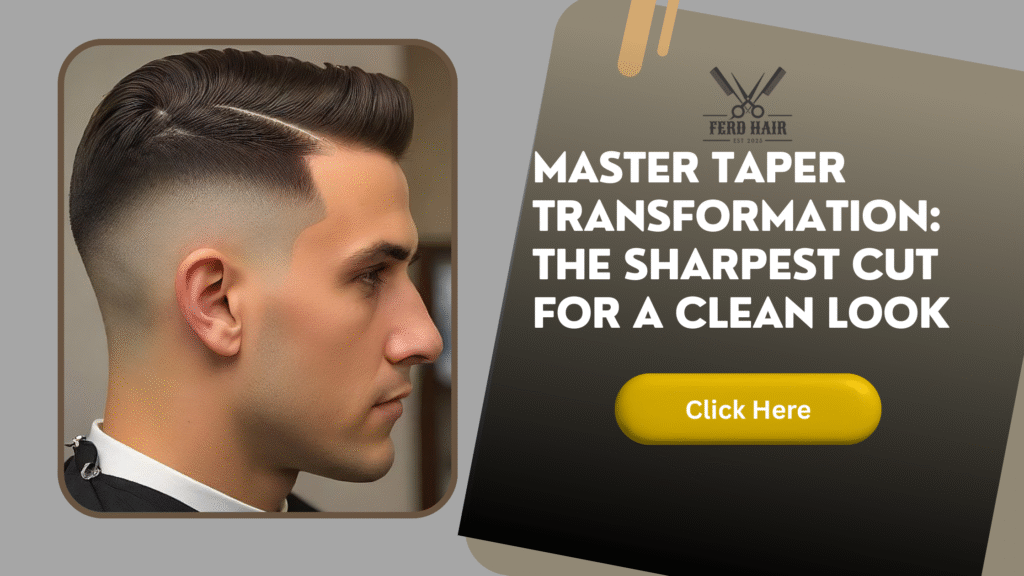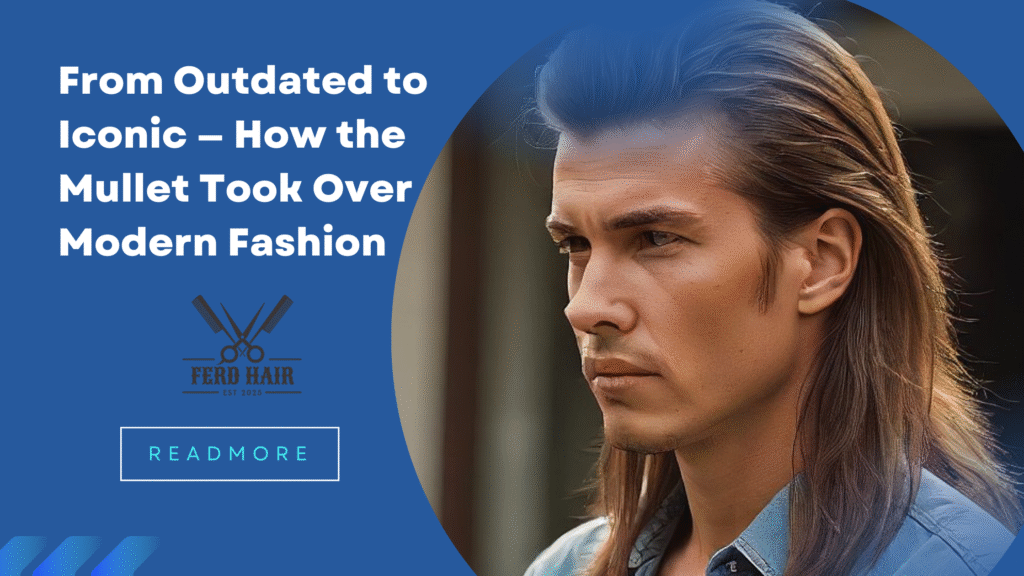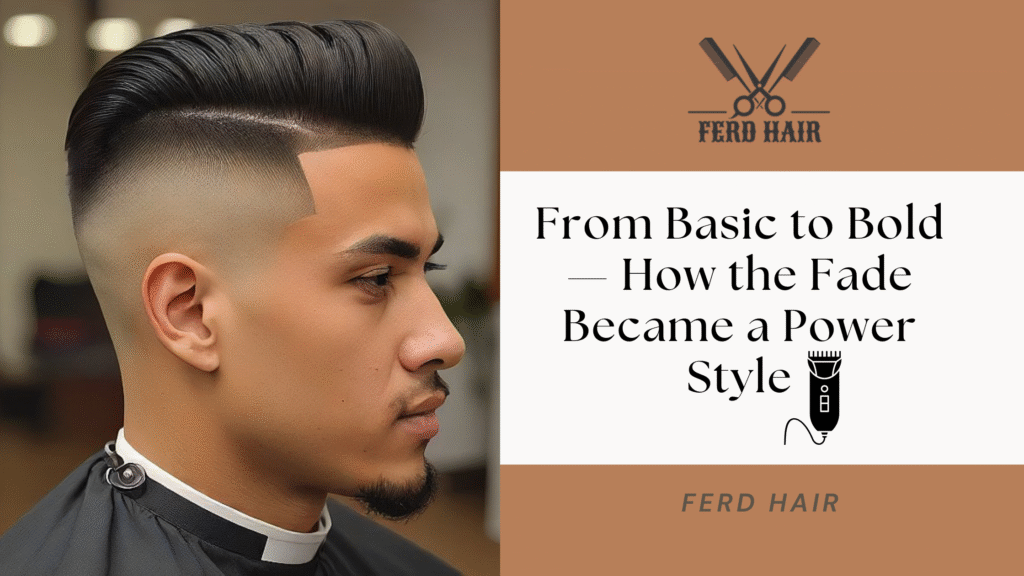Table of Contents
Introduction: Why the Taper Never Goes Out of Style
When it comes to male grooming, certain haircuts are time-specific, and other haircuts are time-tested, and one such time-tested haircut is the taper. The taper haircut is characterized by a smooth gradation, gentle fade, and a sharp finish, having smooth lines and fabulous style to match. Also, whether you seek something low and easy to take care of or a polished, just out of the barbershop style, the taper is a staple trim that will provide you with flexibility and impressiveness.

The most iconic feature of the taper is its versatility. It suits almost all face shapes, hair textures, and easily finds its way to both informal and formal occasions. Whether it is business executives, athletes, or even the fashion-forward creators, more men are opting to sport the taper due to its nonchalant, dapper look.
Here, we explain everything about becoming a taper transformation expert; how to select the best form of taper, and how to have that fresh appearance day after day. So, are you ready to know why the taper is the sharpest cut in the game? So, what are the games especially made up just for kids? Let us plunge in.
What Is a Taper? Understanding the Basics
Barbering, a taper is the steady decreasing of the hair of the crown of the head, down to the natural hairline of the sides and behind. A taper is aimed at making a gradual fading transition that ends up untouched and crisp on the neckline and sideburns.
Whereas a fade may cause the observer to feel that the person has a skin-close finish, a taper tends to leave something more rather than just disappear into the hairline. It is not as dramatic as an undercut that is usually characterized by the sharp contrasts between the long or longish hair on the top and either shaved or extremely short sides. There is almost nothing to contend with the taper haircut that is both elegant and practical, and a favourite of those who walk the razor line between professional and trendsetter (or in-betweener).
The trademark style? Natural, finely manicured gradient which becomes shorter around the ears and neck and stays long and shaped on the top one, therefore creating a clean and controlled look.
The Taper Revolution: From Classic to Contemporary
It is part of grooming necessities that have dominated decades with a taper haircut. It became the most popular men’s cut first in the middle and later parts of the 20th century, and it was the trim of choice among men seeking a tidy and orderly look, in particular in a military or athletic, or business climate.
The taper of today is not at all vintage. The contemporary taper has been developed to contain texture, volume, and styling variations that suit current fashion-conscious preferences in fashion. Barbers now use precision to personalize a taper cut thanks to the aid of the tools, specifically a combination of items, including clippers and trimmers, and styling products.
So, why is it getting so much more popular nowadays? It can be found in versatility. Michael B. Jordan, Zayn Malik, and even Cristiano Ronaldo tapers are celebrities who proved that a taper can easily translate to street style, as well as a red-carpet look.
Popular Types of Taper Haircuts to Know

There are bad tapers and good tapers. Depending on whether you want to look subtle or sharp, these are the most popular variations of tapers you should know:
Low Taper
A slight, delicate taper beginning slightly above the front of the ears and not at the neckline. Perfect when you have a conservative or professional taste.
Mid Taper
An even taper that started in the middle of the sides. It has a contemporary, well-blended appearance that is not that dramatic.
High Taper
Having a bold taper that begins higher along the head, giving a more intense contrast between the top and sides. The shredded tops or punk styles are usually complementary with it.
Taper Fade
A myriad of tapering and fading. It is tidy, crisp, and much favored by the customers of the barbershop who require a smart and low-maintenance haircut.
Temple Taper / Burst Taper
Concentrated over certain regions, such as the temples, or behind the ears. Ideal to work with curvy or large hair and at the same time maintain edges sharp.
Both types of styles have a specific feel to them, and with that said, it is not hard to see a taper haircut that fits your persona and your grooming aspirations.
Check Out: From Basic to Bold — How the Fade Became a Power Style.
Who Should Get a Taper? Face Shapes, Hair Types & Style Goals
The taper is great because it works on just about everyone, but certain differences can enhance the beauty.
Best Tapers by Face Shape:
- Oval: Can wear just about any variation of taper.
- Round: A high or mid taper can assist in making it long and structured, and add to the face.
- Square: Low tapers are used and do not dominate features on the face.
- Heart: The temple tapers can be used to counter the broader forehead and slimmer chin.
Best Tapers by Hair Type:
- Straight Hair: Such hair suits well with straight taper and clean fades.
- Curly Hair: Curly hair can be tamed by a curly taper that holds the shape.
- Thick Hair: Hair types that have more thick hair with tapers, which provide structure and bulk, are removed without sacrificing density.
- Thin Hair: A slight taper is neat, but not too much of the scalp is shown.
Match Taper to Your Style Goals:
- Professional look: A low or midnight taper is used, and the side part has to be clean.
- Trendy and textured: High taper or taper fade and thick on top.
Taper vs. Fade: What’s the Real Difference?

Clean and stylish haircuts are something that a customer might order when they visit a barbershop. One of the common patterns is taper hair and fade hair. Even though they may seem similar on the surface, these two differ in some very important ways in terms of approach, appearance, and their actual purpose, making them unique. Knowing all these differences will guide you to choose the best look you would like to adopt as per your style and what you would want to uphold.
Visual & Styling Differences
- Taper: A taper haircut is one where there is a gradual shortening of the hair on the top of the head down to the neckline and sideburns. This transition is gentle, and does not go past the ears and to the back of the neck. The taper will complement your current hairstyle and maintain the edges to be cool without being too out there.
- Fade: A fade is a more theatrical variation of a taper. It is dealt with a more contrast between lengths, and may mix hair down to the skin (zero or bald fade) or very short stubble. Fades may be initiated at high, middle, or low and produce a more aggressively styled appearance than a conventional taper.
When to Choose a Taper Over a Fade
Choose a taper if you want:
- A less extreme style that is more natural and conservative
- An easy-to-take-care-of haircut
- Work/formal-wear clothes have a professional and clean look
- To preserve the length of some hair at the sides and neckline
Choose a fade if you want:
- The style that is the most popular and bold One them is the way of saying. It consists of the use of words It is the most popular and bold. One of those is the way of saying it lies in the application of words
- A big top versus the sides
- A policeman-like finish that looks smart
- This contemporary one complements top textured or high-volume styles
Pros and Cons of Each Style
| Feature | Taper | Fade |
| Look | SeksTraditional, mild, thigns bussinss | SeksTraditional, mild, thigns bussinss |
| Maintenance | Fewer headaches to take care of, will naturally even out | Needs touch-ups now and then |
| Versatility | Fits everywhere, every style, and every age | Very fashionable, fashion influencers, and elite modelling |
| Blend | Sanfte, Enzel variante. | sharp or dramatic blend onto skin, or extremely short |
| Best For | Conservative dressing, day wear | style cuts, statement vests |
To conclude, both the taper and the fade are great options, but it comes down to your preference, comfort, and the degree of maintenance that you want to subscribe to. The taper is your best shot in case you want a classic, neat appearance. The fade is just effective when you want to make a statement.
Conclusion: The Taper Is the Ultimate Clean-Cut Classic
The tapered haircut has managed to stand the tide of fashionable hairstyles in the world, which keep on changing all the time. It is clean cut, adaptive, and generally stylish, a blend that fits anybody who is seeking the refined look that befits the modern trend at hand, as well as the standard traditional grooming norms. You can have a low taper to make a delicate refresh, a taper fade to give it a little edge, and this style can work on just about any face shape, hair type, and lifestyle there is out there.
The most awesome thing is that it does not mean you have to be bold to stand out. Knowing how to neatly taper a beard demonstrates that you take pride in the details, and that is what matters in grooming. Learn how to do the taper, and you have learnt how to do elegant style.
For more info: Click Here.
FAQs About the Taper Haircut
1. How long does a taper haircut last before it needs a trim?
Depending on the speed of your hair growth, a taper is usually good up to 2 to 4 weeks. Low tapers can take a little longer, and the sharp fades on the taper may have to be maintained more often, so edges are clean.
2. Is a taper good for all hair types?
Yes! The taper haircut can be applied to straight or curly hair or thick or fine hair. The taper offers one of the most versatile sets of procedures when it comes to haircuts because barbers can tailor its blend and shape according to your hair texture and preferences for the final product.
3. What’s the difference between a taper and a taper fade?
A taper has a smooth look around the neckline and sideburns, whereas a taper fade gives the hair a more pronounced blend, usually up to the skin. The fading is discrete and traditional compared to the fading taper fade, which is more daring and modern.



